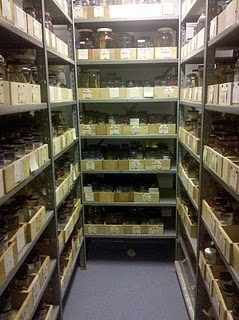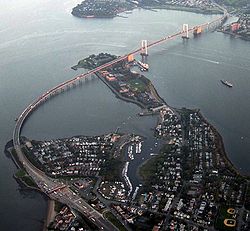Entries in New York (7)
One of the bizarrest parasitic relationships you will ever see
 Monday, June 21, 2010 at 12:40PM
Monday, June 21, 2010 at 12:40PM ![]()
![]() My good colleague Janine Caira wrote a paper way back in 1997 about one of the strangest parasites ever recorded in an animal. This paper has stuck with me ever since, I think because I saw the original photos when I visited the lab of one of the other co-authors George Benz, when he was with Tennessee Aquarium (he's now at Middle Tennessee State U.). So, I thought I'd revive it for you guys; the story goes like this:
My good colleague Janine Caira wrote a paper way back in 1997 about one of the strangest parasites ever recorded in an animal. This paper has stuck with me ever since, I think because I saw the original photos when I visited the lab of one of the other co-authors George Benz, when he was with Tennessee Aquarium (he's now at Middle Tennessee State U.). So, I thought I'd revive it for you guys; the story goes like this:
Janine and her colleagues were unable to determine the path of entry, but they showed good evidence that the eels were alive in the heart prior to the shark being killed and put in the fridge, because their guts were full of blood and there were pathologic changes to the heart. Their conclusion? That this was a facultatively parasitic relationship. In other words, the eels didn't need to be living in the sharks heart (that would be obligate parasitism), rather they took advantage of an opportunity to get a meal. They proposed that the eels probably attacked the shark after it had been hooked and was dangling, distressed, from the longline. They had some evidence that the shark was probably resting on the bottom, which may have made it easier for the eels to find. The pugnoses somehow gained entry (hypothesised to be through the gills) and made their way to the heart, where they dined on the beasts blood up until it died. Maybe they would have burrowed out again after the animal expired, maybe they would have suffocated (remember - the eels had be swimming in and breathing the sharks blood once they were inside, how bizarre is that?). We'll never know because the carcass went in the fridge, which ended things for the eels, but also led to this amazing discovery.
The horrifying part is that the shark was almost certainly alive as the eels made their way into its flesh and began to consume its life blood from the inside. It would have been a long, slow and nasty way to go out. It just goes to show that even when you are at the top of the food chain, you're never really at the top of the food chain...
Caira, J., Benz, G., Borucinska, J., & Kohler, N. (1997). Pugnose eels, Simenchelys parasiticus (Synaphobranchidae) from the heart of a shortfin mako, Isurus oxyrinchus (Lamnidae) Environmental Biology of Fishes, 49 (1), 139-144 DOI: 10.1023/A:1007398609346
No rest for the wicked
 Sunday, May 30, 2010 at 7:54AM
Sunday, May 30, 2010 at 7:54AM Returned from the Eastern Fish Health Workshop in the DC area yesterday, after our flight got canceled on Friday. It was a fantastic meeting, for all the reasons I cited in my previous post.
I've got one day at work today and then off to Mexico for field research with Mexican government colleagues this week (more about that later), but not for long, because teaching duties in NY on Friday and Saturday call. While I am in NY, I'll be giving a public lecture about whale sharks at Stony Brook Southampton on the 4th at 1930hrs. Its part of the SoMAS Spring lecture series; I'd love to see you there!
The Type Room
 Tuesday, April 20, 2010 at 6:12PM
Tuesday, April 20, 2010 at 6:12PM AMNH the reprise
 Tuesday, April 20, 2010 at 9:58AM
Tuesday, April 20, 2010 at 9:58AM It was a long but fantastic day at the Museum yesterday. After Bento boxes with the grad studets, I met with folks from their comparative genomics and conservation genetics group including George Amato and Rob deSalle. Then out for refreshments with the leech lab folks and their intrepid leader and old colleague of mine Mark Siddall. We gasbagged about everything from progressive metal to the latest leech they described, Tyranobdella rex, from up the nose of an unfortunate Peruvian child. What an awesome name. You can read more about it on Mark's blog Bdella Nea, linked from my blog roll somewhere hereabouts.
I didn't get to do everything on the agenda yesterday, so its back to the museum today to meet with people from Ichthyology and take a look at the fish type collection (drool). I might just snag some bit-o-critter pics from among the jars...
Field locations you have loved
 Saturday, April 10, 2010 at 11:25AM
Saturday, April 10, 2010 at 11:25AM In this thread I want to hear about field locations YOU have loved, and WHY. Here's a couple of mine to get the ball rolling:
 Kedron Brook, Brisbane, Australia. A choked little stretch of suburban creek on the north east side of Brisbane Australia was a key field location for my PhD research, which was all about introduced (exotic) species and their parasites in rivers and streams in Australia. At one point just above the tidal influence - stylishly named KB216 for its map reference - this creek is basically completely exotic: plants, invertebrates, fish, the whole shebang. There aren't many parasites there, but those that were present were introduced hitchhikers. Not sexy, but a veritable Shangri-La for a student on the hunt for ferals...
Kedron Brook, Brisbane, Australia. A choked little stretch of suburban creek on the north east side of Brisbane Australia was a key field location for my PhD research, which was all about introduced (exotic) species and their parasites in rivers and streams in Australia. At one point just above the tidal influence - stylishly named KB216 for its map reference - this creek is basically completely exotic: plants, invertebrates, fish, the whole shebang. There aren't many parasites there, but those that were present were introduced hitchhikers. Not sexy, but a veritable Shangri-La for a student on the hunt for ferals...In the comments, tell us about a field location YOU have loved and why. Post links if you can find them.
 3 Comments |
3 Comments |  Email Article | tagged
Email Article | tagged  Australia,
Australia,  Brisbane,
Brisbane,  GBR,
GBR,  Heron Island,
Heron Island,  Long Island Sound,
Long Island Sound,  New York,
New York,  coral reef,
coral reef,  ecology,
ecology,  estuary,
estuary,  exotic,
exotic,  feral,
feral,  fieldwork,
fieldwork,  fish,
fish,  hypoxia,
hypoxia,  invertebrate,
invertebrate,  parasites,
parasites,  turtles
turtles 







